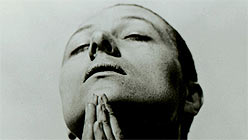It’s not true that the only reason to watch a bunch of films by the Danish director Carl Theodor Dreyer is to be able to answer for yourself which ones are the masterpieces, and the best films ever made, and why. But that’s as good a place to start as any.
Eloquent testimony to Dreyer’s greatness is not hard to come by. Luminary critics from every era of film history have staked their reputations on him. François Truffaut saw him among “the kings of the first generation of cinema, the generation that mastered, first, silence, and then sound.” Paul Schrader launched his career on a thesis about Dreyer’s “Transcendental Style.” Jean-Luc Godard said his piece on Dreyer cinematically, with Vivre Sa Vie, by sending Anna Karina into the peculiar crucible of a movie theater, where she sees and resembles Maria Falconetti as Dreyer’s Joan of Arc.

“Day of Wrath”
You can do likewise at the Paramount Theatre in Oakland on December 2, and warm up in the meantime with a month’s worth of Dreyer at the Pacific Film Archive. If a whole spate of movies wracked with metaphysical seriousness does not at first appeal, try anyway. It starts tonight (Friday, Nov. 5) with the illuminating double feature of Day of Wrath, the medieval witch-trial drama Dreyer made in 1943, when the Nazis occupied Denmark, and Godard’s aforementioned veneration, from 1962, itself described by Manny Farber as “a film of extraordinary purity.”
That’s obviously a product of the master’s influence: Purity is of the essence in Dreyer’s films, which — having generally forgone the self-dating festoons of technique for more enduring cinematic ingredients, like the searching, searing close-up — often concern themselves with purifications. Although not inclined to pontificate, Dreyer wanted to examine mankind’s problematic receptiveness to spiritual power. He did not flinch from his findings. The Passion of Joan of Arc, from 1928, was the benchmark, but not the beginning. Nor was it the end of an affinity for disempowered or downright oppressed protagonists, usually female, that endured until his final film, 1964’s loveless-marriage drama, Gertrud. There is even a purity and palpable command of presentation in Dreyer’s proto-horror classic Vampyr, from 1931, which was funded by its own lead actor, a baron, who looks in the movie like Franz Kafka crossed with Jimmy Stewart.



